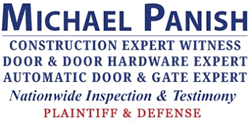The overhead or floor mounted concealed door closer is a very common type of door closer mechanism which is normally unseen and unnoticed. In the majority of installations, these concealed closers are used on aluminum glazed storefront doors, hollow metal stand alone, or structural framed window systems. The concealed door closer design concept was initially engineered as a self-contained product that featured a center pivot allowing a variety of door functions with no exterior arm or visible operating hardware. Other types of concealed door closers have the closer mounted into either the header or floor area of a door with observable arms that either exert the force of the closer on the door or limit the door swing travel. Subsequent development of the concealed closer has led to specifically functioned products that required advance knowledge of door swing, handing, and degree of opening prior to purchase and installation. In some concealed closer products the pivot of the closer interacts with a piece of provided hardware that allows for limited adjustments of the door travel undetermined at the time of purchase. But, most devices are specifically limited to the functions ordered by the contractor or installer. Some concealed closers only allow single directional control for opening and closing to a fixed point or door stop. Dual action devices that will swing open and close in both directions are also common and have specific adjustment limitations.
There are many variations and potential uses that allow special operations and cycling of doors with these concealed products. Functions such as hold open, delayed closing, and door swing management are all possible. With some products, the concealed closer must be specially handed for either right or left hand installations. Dual action closers where the door sweeps in either direction are also available with additional hold open and delay functions. Typically, the choice to use a concealed closer has to do with the desire to provide a finished clean appearance free of a piece of hardware positioned on the door or frame of an opening. In contrast to the box like surface mounted closer commonly found on doors in hotels, hospitals and other commercial venues, concealed door closers are completely hidden to most observers.
Depending upon the make and manufacturer of the concealed door closer, installation of these products places the closer mechanism and attached hardware in a variety of potential installation locations that require advance planning during fabrication of the door system. A pocket trough in the framed door header, top door rail area, or installation into a channel or floor box or bottom door rail requires advance planning and fabrication specialties.
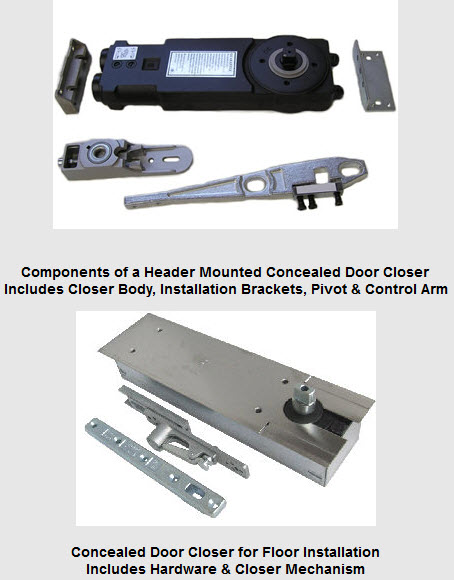
Some concealed closers function with butt hinges for one way traffic, while others are designed using only pivots to swing the door. The choice of either type of hinges used limits certain aspects of the door system. In the case where butt hinges are applied, the door can only open in one direction as designed. A door stop is usually incorporated into the frame of the door to prevent damage to the door, hinges and frame. The potential options that can be associated with a butt hinge installation include hold open vs. non-hold open functions, delayed closing functions, specific handing requirements when ordering the concealed closer, and desired opening swings from 90 to 270 degrees. Where a pivot hinge installation is chosen, all of the functions mentioned with the butt hinge installations apply except the travel of the door can be either inward or outward, so no door stop is installed. Some concealed door closers are generally unhanded or universally adaptable, but may be limited to a specific opening span due to the central location of the pivot points.
The use of concealed closers also comes with the same duties and responsibilities for maintenance that a standard surface mounted closer requires. A common problem with concealed closers is that owners and property managers frequently do not understand where the closer is located or what they need to do to maintain and check the condition of the installed closer. Special installations may require additional or more frequent service and maintenance. When concealed door closers are positioned on the bottom of a doorway, and the pocket for the closer is located in a floor where constant exposure to moisture from outside weather elements or routine mopping are present, special added inspections are important.
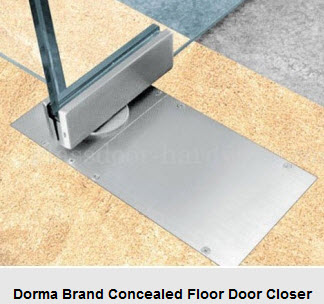
As with any door closer, there are a few different designs that are found throughout the industry. There are several manufacturers that have merged over the past few years that provide identical products with different manufacturer's names and model numbers. Appropriate care must be taken to replace a defective closer with the proper product. Many of the current closers look similar to an "inexperienced eye", and may not be the proper replacement for a defective product.
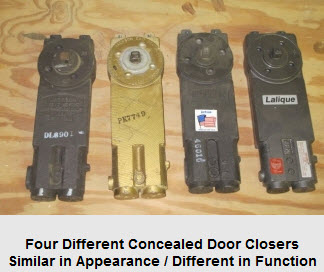
If improper replacement door closers are installed, they can possess functions that were not present in the originally installed closer and potentially alter the performance of the door with significant detrimental effects. An improperly chosen replacement door closer can be over or under powered creating damage to the door and frame. The closer can have an improper swing path, allowing the door to over travel and create cosmetic as well as structural damage to both the door and frame. An improperly handed replacement closer can cause the door to move in a contrary direction of travel, and lead to a path of travel or life safety issue. Most good quality door closers are manufactured to specific standards for ADA and life safety compliance. Improper or malfunctioning closer mechanisms can negate the compliance of these standards even though they were originally in compliance at the time of manufacture. Foreign door closers are often out of compliance even when purchased new from the manufacturer. It is essential that appropriate products be used on all installations to avoid non-compliance that may lead to serious bodily injuries.
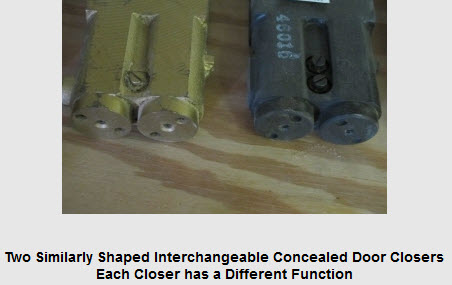
Most of the concealed door closers I have furnished as a contractor and observed as an expert during site inspections have been installed in aluminum storefront or hollow metal door and framed products. Concealed closers are also used in many other situations. Applications that use wood and laminated swinging doors in conjunction with specialty wood and synthetic frame products have also been observed during my expert site visits and professional installation career. It is essential to note that special door preparations are needed to properly structure and support the door closer components in wooden, synthetic, and metal doors and frames alike. These door pockets and frame recesses are built into the door systems at the time of the fabrication of the door and frames. Concealed closers installed into doors and frames made from wood or other products less resistant to stress and torque than metal products can be problematic. The fabricator must really understand the potential forces that can be exerted by a normally functioning concealed door closer and a malfunctioning concealed door closer. In past personal injury cases where I was retained as expert, the failure of several fabricators to provide the required structural integrity has resulted in serious personal injuries.
MAINTENANCE
Many door closer injuries can be attributed to improper maintenance or lack of proper instruction or awareness that the closer needs attention on a regular basis. In a commercial environment the volume of traffic associated with the opening should dictate the intervals for service of any door closer mechanism. Door closers should be checked daily for proper attachment, evidence of leaking fluids, force of operation, and wear of components. The door should be taken out of operation if any problems are observed. A professional and qualified service provider should repair or replace the defective door closer or offending door component, and the problem should be completely corrected prior to allowing further usage of the doorway.
Michael Panish is the most frequently retained expert witness in the country for both plaintiff and defense cases involving overhead doors, automatic doors, and manual door systems. He has a thorough understanding of these door systems and a hands-on background that provides a basis for his expert opinions and working expertise. Mr. Panish has been retained on numerous cases that have quickly resolved after his involvement. He has been brought into many cases to replace previous experts that were unable to explain or identify the issues of causation. He has personally serviced, installed, and maintained major brand door products for many years. He is the author of many articles that cover most aspects of door components, door hardware, and door injury claims. Visit his website at www.constructionwitness.com for a list of relevant articles and to view all of his expert and consulting services.
©Copyright - All Rights Reserved
DO NOT REPRODUCE WITHOUT WRITTEN PERMISSION BY AUTHOR.


